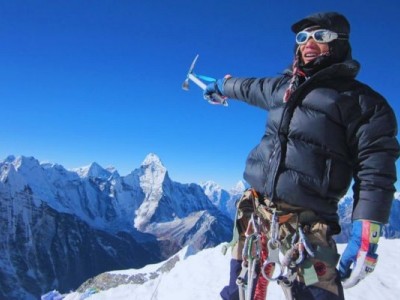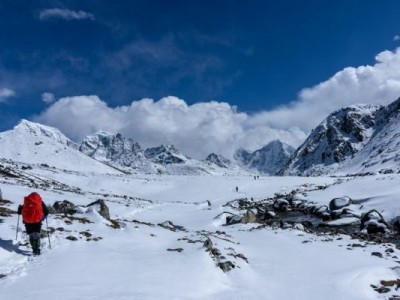When Is the Best Time to Trek Pikey Peak? Understanding Nepal's Seasons
Nepal experiences four distinct seasons—Spring, Summer/Monsoon, Autumn, and Winter—each bringing unique weather conditions that affect trekking. Choosing the best time for Pikey Peak trek is essential, as the right season enhances visibility, trail conditions, and overall enjoyment.
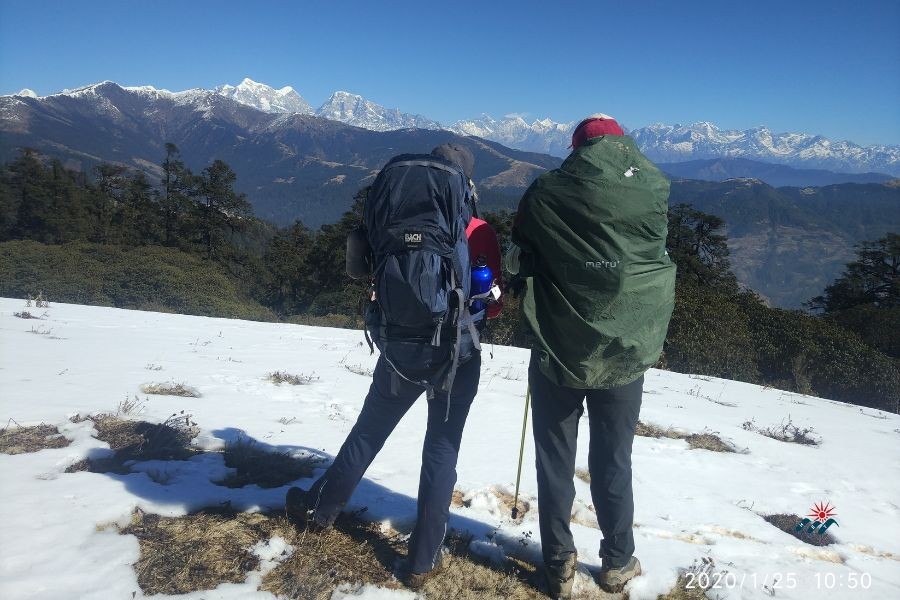
While Pikey Peak is accessible throughout the year, each season presents advantages and challenges. Here’s a quick breakdown:
Nepal’s Four Trekking Seasons & Their Impact on Pikey Peak| Season | Months | Weather & Conditions | Pros | Cons |
| Spring | March - May | Mild temperatures, blooming rhododendrons, and clear views | Best visibility, colourful landscapes, stable weather | Popular season, moderate crowding |
| Summer/Monsoon | June - August | Hot, humid, heavy rainfall, leeches on lower trails | Lush greenery, fewer trekkers | Slippery trails, poor visibility, and landslides |
| Autumn | September - November | Cool temperatures, crisp air, and excellent visibility | Best time for clear skies and breathtaking views | More trekkers on the trails |
| Winter | December - February | Cold, chances of snowfall, dry trails | Fewer crowds, clear skies, and unique snow-covered landscapes | Very cold nights, potential snowfall |
Springtime Pikey Peak Trek: The Vibrant Awakening of Nature
Spring (March to May) is considered one of the best times for Pikey Peak trek in Nepal, offering a perfect balance of pleasant weather, clear mountain views, and vibrant landscapes. Ideal time for Pikey Peak trek, this season ensures an unforgettable experience with blooming flora and mild conditions.
Temperature & Weather Conditions
Daytime temperatures: 10°C to 20°C (50°F to 68°F). The temperatures during night fall into the range of -5°C to -10°C (23°F to 14°F), which becomes evident at higher elevation points. Stable weather with minimal chances of rain or snowfall. Mild temperatures make trekking comfortable.
Rhododendron Blooms & Wildlife Viewing
Every hill slope becomes vibrant and colourful because the rhododendron forests are fully blossoming during this season.
The landscape contains green meadows alongside wildflowers that increase its visual appeal.
The hills allow for wildlife sightings that include musk deer and langurs, with numerous species of birds.
Visibility & Mountain Views
One of the best seasons for crystal-clear views of Everest, Makalu, Kanchenjunga, and Annapurna
Because there is less air haze than during the summer, stunning sunrise and sunset views are guaranteed.
Difficulty Level & Trail Conditions
Experienced trekkers and new members become equally likely to reach the destination due to moderate trekking conditions.
Well-defined trails with minimal risks of landslides or heavy snow
The spring season maintains temperate conditions that lower the probability of altitude sickness manifestation.
Crowds & Accommodation Availability
The tea houses along with lodges experience moderate traffic during this peak season which is less crowded than Everest Base Camp.
People should book their accommodations ahead of time during the busiest months of April and May.
Pikey Peak in Autumn: The Perfect Time for Clear Views
Autumn represents the perfect time for Pikey Peak trek, providing good, consistent weather along with clear mountain views from September to November. The best time to trek Pikey Peak is during this season, as it stands as Nepal's high trekking period, drawing numerous mountaineers from around the world.
Weather & Trail Conditions
During daytime the temperature ranges between 10°C to 18°C (50°F to 64°F), but nights at upper elevations turn freezing cold with -5°C (23°F). Smooth trekking takes place because the climatic conditions remain dry with clear skies. The monsoon follows up by creating extensive natural beauty through its effects on the landscape, which includes distinct pathways and lively streamflows.
Stunning Mountain Views & Photography
Autumn delivers optimum conditions for watching the clearest views of Everest, Kanchenjunga, Makalu, and Annapurna because the atmosphere maintains dry conditions and exceptional visibility. The Himalayas create a breathtaking display when Sun touches their peaks during both sunrise and sunset from Pikey Peak. This particular period presents ideal conditions for panoramic photography as well as stunning picturesque views.
Festivals & Cultural Experiences
Surviving between September to December makes it possible for visitors to experience Dashain and Tihar festivities as well as watch traditional village decorations and observe lively music performances during Nepal's major autumn events. The tea houses located along the trek feature vibrant festivities which provide trekkers special cultural interactions.
Are there conditions to trek Pikey Peak during winter months? Cold Weather Trekking Guide
The conditions of winter allow safe Pikey Peak trekking between December and February although additional planning is necessary. Throughout winter, you can find pleasing hiking paths while seeing fewer people and stunning mountain scenery because of clear blue sky conditions. While the best time to trek Pikey Peak is often considered autumn, winter offers a unique experience for adventure seekers who are well-prepared for the cold.
Temperature Ranges & Daylight Hours
The daytime temperatures range between 5°C to 10°C (41°F to 50°F), yet nighttime temperatures here decrease to -10°C to -15°C (14°F to 5°F) in higher altitude regions. January, together with the beginning of February, represents the period with the most extreme cold temperatures. People need to plan their trekking activities carefully due to the shorter daylight hours that lead to sundown between 5:30 PM and 6:00 PM.
Snow Conditions & Trail Accessibility
The altitude receives gentle to average snowfall during this period. An ascent of the Pikey Peak viewpoint from 4,065 meters becomes more demanding due to snowy paths on the trail. The lower courses stay operational, although they may be slippery, so users should exercise caution with the optional microspike attachment. Detailed plans need to be flexible because certain trail areas could develop complete barriers during heavy snowstorms.
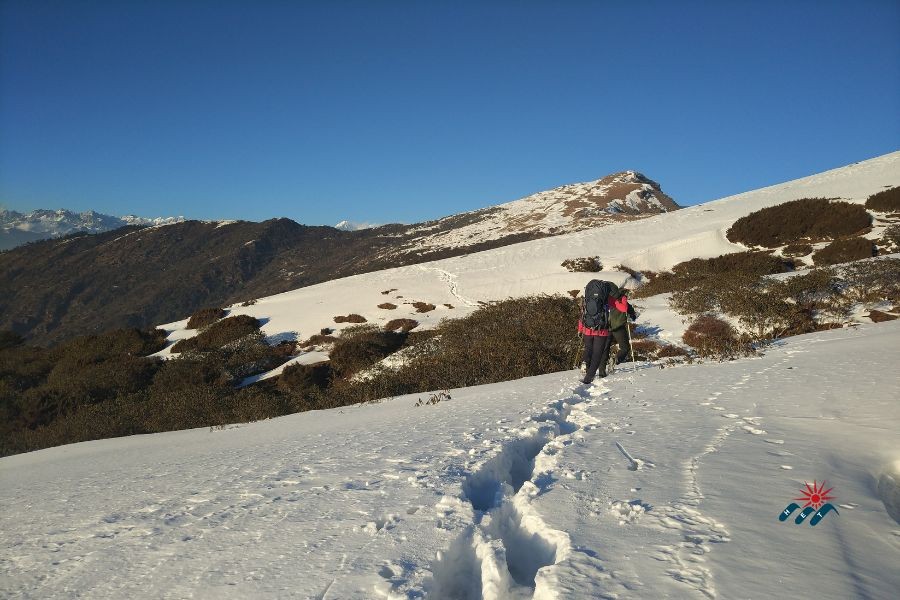
Required Gear & Preparation
The necessary attire for winter trekking includes layered clothing that combines insulation and wind protection features for outdoor comfort. The path to success demands waterproof trekking boots along with suitable boots that provide secure footing during wintertime walking. A thermal sleeping bag serves as an ideal choice since many teahouses provide inadequate blanket supplies. Marching through snow and ice requires crampons (microspikes) or microspikes as essential tools, and you should protect your eyes with sunglasses and apply sunscreen during intense sun glare.
Accommodation Limitations
Closures along with food shortages are common occurrences in remote teahouses because of deeply freezing temperatures during the winter season. The reduced number of trekkers during this period grants increased possibilities to obtain unreserved accommodations.
Views & Photography Opportunities
The winter season showcases faultless skies revealing exceptional snowy mountaintops. The absence of haze during the winter season provides clear visibility of Everest together with Makalu and Kanchenjunga peaks. The trip becomes especially rewarding for photographers and nature lovers because of the beautiful golden light during sunrise and sunset.
Combining Adventures: Pikey Peak with Dudhkunda
The combination between Pikey Peak treks and a visit to Dudhkunda provides extended journeys because this pilgrimage site sits at the base of Numbur Himal (6,958m) near its sacred glacial lake. Both Buddhists and Hindus respect this trek route, which provides mesmerising landscapes as well as cultural heritage and spiritual importance in the Solu region.
Best Time for Visiting Both Destinations
Travelers can choose spring (March to May) for rhododendron blossoming or autumn (September to November) with stable and clear weather conditions when visiting Pikey Peak along with Dudhkunda. The winter season represents a possible trek window, yet excessive snow can entirely block access to Dudhkunda trails. Monsoon proves unfavourable for visiting these regions due to slippery trails coupled with the presence of leeches and limited visibility conditions.
Additional Days Required
The combined trek of Pikey Peak and Dudhkunda requires ten to twelve days of trekking time because it extends the five to seven days of regular trekking with additional four to five days for Dudhkunda. The proper sequence for this combined trek involves starting with Pikey Peak before moving to Junbesi followed by Taksindu and Saharsbeni to reach Dudhkunda.
Special Considerations for the Combined Trek
The trails past Junbesi remain distant from civilisation and service facilities, so travellers need to organise their plans accordingly. Visitors need to bring camping equipment when visiting Dudhkunda because the area contains fewer lodges than Pikey Peak. Travelers must prepare properly for the high elevation of Dudhkunda because its height of 4,560 meters exceeds Pikey Peak by a few meters.
People who trek to Pikey Peak with Dudhkunda during winter experience magnificent vistas while walking through serene mountain paths. An appropriate level of preparation enables people to experience a distinct Himalayan journey of lasting memories.
Seasonal Variations Affecting Dudhkunda| Season | Trail & Weather Conditions | Considerations |
| Spring (Mar-May) | Stable weather, rhododendrons in bloom | Best time for nature lovers |
| Summer (Jun-Aug) | Heavy rain, muddy trails, leeches | Not recommended |
| Autumn (Sep-Nov) | Clear skies, best visibility | Ideal for photography & festivals |
| Winter (Dec-Feb) | Very cold, snowfall may block paths | Only for experienced trekkers |
When Should I book pikey peak trek? Planning Tips
The selection of proper timing for your Pikey Peak trek will lead to a stress-free experience while securing ideal accommodations and transport options and trekking support. The following guidelines will help you select the perfect moment for your Pikey Peak trek booking.
Booking Windows for Different Seasons
Travelers should book their Pikey Peak Trek during Spring months (March to May) at least one to two months ahead since April stands as the most crowded time. Autumn represents the busiest trekking season from September to November, thus requiring booking of 2-3 months to reserve the best teahouses and flights. Winter months from December to February have reduced trekker traffic, which makes it possible for last-minute bookings, provided you confirm that teahouse establishments are operational. During the monsoon months of June to August, you can make flexible bookings, yet weather conditions include rain and limited visibility.
Peak vs. Off-Peak Pricing
The high level of visitor demand throughout the spring and autumn months leads to increased costs for flight reservations and lodging services. During winter and monsoon,travellerss can access discounted rates on teahouses along with guides and flights, although some services might be restricted. The wages of guides and porters stay constant, yet they might impose additional fees when extreme weather occurs in winter and monsoonTravellersrs should check Guide & Porter availability according to each season.
The peak seasons bring plenty of guides and porters, but winter and monsoon seasons lead to a reduced workforce because of harsh environmental conditions. The availability of services can be secured through booking, yet local hires remain possible in the lower Solu region.
Transportation Considerations
Travellers seeking quick transportation between Kathmandu and Phaplu should book their flights in advance because these flights remain limited during peak tourist seasons. Travellers who opt for a jeep journey from Kathmandu to Dhap will need about 7–8 hours to complete the rout,e with the added benefit of lower costs but potentially challenging road conditions ithe n the monsoon season. During return travel, people should maintain flexibility because mountain flights tend to operate based on weather conditions.
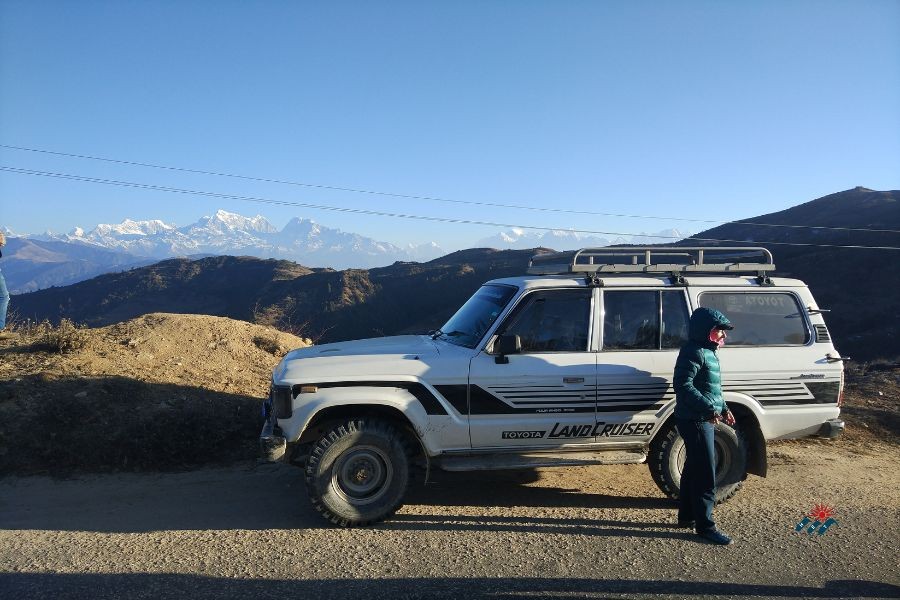
Recommended Duration Based on Season
The trek spans between seven to nine days in spring and autumn, which provides enough time for cultural activities. The reduced amount of daylight in winter forces trekkers to limit their journey to 6–8 days because of the potential snow accumulation. A monsoon trek requires between eight to ten days of travel, along with additional weather delay contingency time.
Your experience during the Pikey Peak trek improves when you book at the appropriate time because it provides comfortable lodging and dependable trekking assistance and easy transportation options. Planned execution leads to both stress-free and memorable Himalayan adventures.
Best Month for the Trekking to Pikey Peak: My Suggestion
Results from weather pattern examinations together with trail conditions and visibility improvements demonstrate that the best time to trek Pikey Peak is October. This month offers crystal-clear views, stable weather, and the perfect balance of pleasant daytime temperatures and cool nights. Fresh air during the post-monsoon season creates enchanted vistas of Everest, together with Makalu, Kanchenjunga, and the other Himalayan mountains. Both trail safety and comfort are maximised by the dry trails that are ideally maintained for walking. Trekking during October presents visitors with the chance to celebrate the two national holidays, Dashain and Tihar, as Nepal celebrates its major festivals at this time.
April serves as the second-best timeframe during spring because it lies in the center of springtime. During this season, the hills transform with pink and white, and red colored rhododendron forests blossom all across the region. The trails present a pleasant climate temperature while showing the vibrant natural scenery. The slightly warmer climate of April contributes to attractive mountain scenery, especially during the morning hours before haze clouds appear in the afternoons.
A reference guide showing monthly weather conditions exists for anyone contemplating an alternate time to visit.
Winters in the national park bring heavy snowfalls during January and February, when extremely cold temperatures exist, yet visitors enjoy peace and breathtaking views of winter nature. The spring season ranks highly with visitors because March and April offer pleasing weather, together with beautiful blooms of rhododendrons. During the last part of May, temperatures continue to increase while small pre-monsoon clouds begin reducing visibility.
Heavy monsoon rain, together with challenging slippery paths, restrict mountain views during the three months of June through August, thus rendering this period the worst time to visit. The best time to trek Pikey Peak commences in September when weather conditions improve along with the growth of fresh green plants due to monsoon rain. The months of October and November prove to be the perfect time for trekking because they give clear views while providing the most suitable conditions. December introduces colder conditions, although the first part of the month still allows trekking across higher trails.
Guides in the region declare October to be the ideal month when visitors can experience peak views under strong weather patterns. Experienced guides suggest April as an equally valuable period because scenic beauty combines with tolerable weather conditions. The guides warn against trekking in the rainy season unless the visitor explicitly wants the solitude and uncertain elements of wet weather. People should avoid winter trekking unless they have proper cold-weather preparations along with the ability to handle unpredictable route conditions.
Participants who choose their time to visit Pikey Peak stand to enjoy the best experience although they can reach the destination at any point during the year. Completing the Himalayan trek at its best time, either in autumn's fresh air of October or during April's trail beauty, guarantees a remarkable mountain expedition.
Practical Considerations:
Weather-Specific Packing Guide
The Pikey Peak trek requires correct packing which provides sanctuary and comfort throughout the journey. The season you choose for your expedition has a significant impact on the gear you'll need for the hike. A well-prepared trekker maintains their safety by adapting to weather changes and reducing their carrying weight to ensure confident trekking.
Essential Gear for Each Season
The weather conditions throughout Spring (March–May) and Autumn (September–November) are similar, so they require analogous packing items because of their mild temperatures. A light down jacket combined with breathable trekking clothing, along with a proper pair of trekking boots, makes up the necessary equipment. Using sunglasses with sunscreen, along with wearing a wide-brimmed hat, becomes essential because of the powerful Himalayan sunlight. Using trekking poles enables safer navigation on steep terrain, while you need a sleeping bag suitable for temperatures below -5°C (23°F) to have a comfortable night in teahouses.
The cold season requires heavy layers, starting with a thick down jacket, along with thermal base layers and rainproof gloves and insulated boots that will keep out the extreme cold during December through February. To get through the teahouse's limited blankets, the traveler must have a four-season sleeping bag which can handle temperatures down to -15°C (5°F). For icy terrain trails use Microspikes or crampons along with a headlamp, which should have backup batteries because of the limited daylight duration.
Rains during June through August necessitate absolute waterproof clothing consisting of full protection with jacket and pants, and a waterproof backpack coating alongside quick-draining clothes. The essential equipment for preventing falls on slippery terrain comprises waterproof trekking boots. A mosquito net and insect repellent help against leeches and other insects in lower regions.
What to Leave Behind
Packers who are preparing for an outdoor adventure tend to make the mistake of bringing too many items. Heavy casual clothing items should be avoided because you will spend most of your time in trekking gear. The utilization of big bottles of shampoo along with having numerous shoe pairs creates avoidable weight problems. During spring and autumn seasons visitors do not need heavy winter clothes yet during monsoon times a thick down jacket becomes useless. A compact camera tripod stands as a better option than cumbersome large camera tripods.
Renting vs. Bringing Equipment
Those who trek seldom can benefit from gear rental services available in both Kathmandu and Salleri, since it reduces their overall costs. Trekking poles and crampons, together with down jackets and sleeping bags, are all available for rent at costs substantially lower than their new market prices. Despite their value, hiking boots should only be your pair because both new and poorly fitting boots will result in blisters, which create discomfort. Buying a high-quality backpack together with trekking poles along several base layers becomes beneficial if you intend to perform multiple treks.
Season-Specific Health Considerations
The cold weather presents two health concerns of hypothermia and frostbite, which make quality gloves and socks essential for warmth protection. Altitude sickness becomes a concern for spring and autumn trekkers because the mild weather conditions deceive them, so they need to constantly hydrate themselves. Bacterial infections that occur through contaminated water and leech bites during monsoon require preventive measures such as water purification tablets and long socks. Before any trek, it is mandatory to have a first-aid kit containing altitude sickness medication, painkillers, and painkillers with rehydration salts, no matter what the season.
Proper seasonal item selection will help create a comfortable trekking adventure. When preparing for changing weather conditions while selecting between rented equipment or personal gear and staying equipped with essential supplies, you will enhance the chances of trekking success.
Conclusion
Trekking Pikey Peak provides adventurers breathtaking Himalayan vistas together with unique cultural discoveries within unexplored parts of the mountains. The timing of your trek plays a vital role in achieving excellent results from this experience. Autumn represents the perfect trekking period because its steady weather and visible skies produce the optimal trail conditions during September–November. In addition to the stunning rhododendrons that produce a vibrant landscape throughout the region, spring (March–May) offers mild temperatures. The snowy wilderness of winter trekking between December and February brings solitude to trekking enthusiasts with snowy landscapes, but monsoon between June and August remains the least recommended due to unsafe conditions involving rain and slippery trails, and diminished visibility.
Tourists should secure their reservations early when peak times arrive, as they need to bring appropriate clothing for changing weather patterns and make Dudhkunda their next destination for an all-around adventure. Safety and enjoyment during Everest Base Camp tours become possible through adequate preparation and expert guide selection, and choosing the right travel month.
If you're thinking about trekking Pikey Peak, let us know your questions, and we’ll be happy to assist you. Happy trekking!
FAQs
Why Combine Pikey Peak & Dudhkunda?
- A diverse adventure featuring Himalayan views, alpine lakes, and Buddhist monasteries
- Less-crowded alternative to Everest Base Camp with rich cultural experiences
- Perfect for those with extra time, seeking an off-the-beaten-path journey
Why Choose Autumn for Pikey Peak Trek?
If you’re looking for the best month for Pikey Peak trek, October and November are ideal. The stable weather, breathtaking visibility, and cultural richness make autumn the perfect time for the Pikey Peak trek.
Why Choose Spring for Pikey Peak Trek?
Spring is a perfect time for Pikey Peak trek if you love vibrant landscapes, stable weather, and breathtaking mountain views. The rhododendron forests, pleasant temperatures, and clear skies make it an unforgettable experience.
Ready to Experience Pikey Peak with Purpose?
At Himalayan Ecological Trekking, we do more than just guide you through the Himalayas — we help you experience them responsibly. Our treks are rooted in eco-friendly practices, supporting local communities and preserving the natural beauty of Nepal.
Planning your trek? Join us for a free online trip briefing where we’ll walk you through everything you need to know — from what to pack to what to expect on the trail. Inquire Now: [email protected], Online Briefing: WhatsApp: +977 9851006023 (Bikesh)
Trek sustainably. Travel consciously. Choose Himalayan Ecological Trekking.
Book your eco-friendly adventure today!



